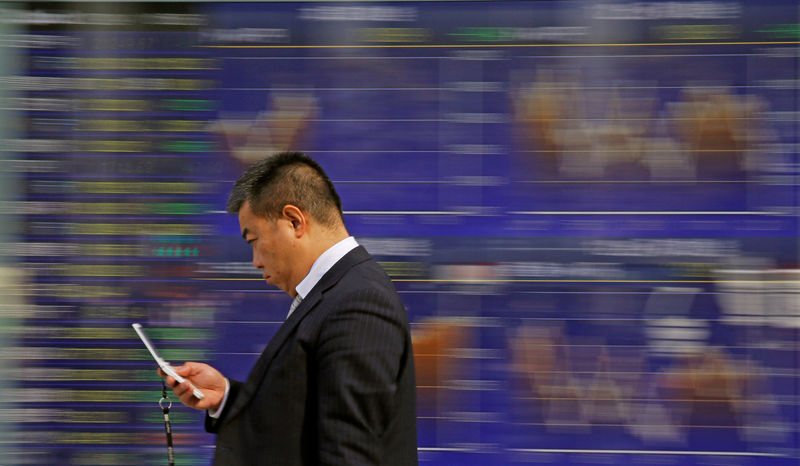 © Reuters. A man walks past an electronic stock quotation board outside a brokerage in Tokyo
© Reuters. A man walks past an electronic stock quotation board outside a brokerage in TokyoBy Marius Zaharia
HONG KONG (Reuters) – Asia’s relatively stable bonds and money markets seem immune to the inflation fears that convulsed global equities recently, as investors bet the continent’s major economies will keep interest rates low as price pressures remain benign.
The stock market rout began at the end of January, when U.S. wages posted their fastest growth in more than eight years, fuelling expectations that the Federal Reserve’s decade-long struggle to bring inflation back was finally bearing fruit.
That goal moved a step closer as data on Wednesday showed U.S. consumer prices rose more than expected in January.
Central banks in the euro zone, Britain and Canada were also more upbeat on the inflation outlook, contributing to a fall of over 10 percent in the MSCI’s 47-country world stocks index in about a week – a move which has since retraced slightly.
While Asian stock markets were taken hostage by the sell-off on fears faster rate hikes could hit global growth, short-term interest rates held steady or even dipped as investors saw an opportunity to trade the divergence in rates.
“When you buy the Kospi (stock index) in Korea, you’re not buying because Samsung (KS:) is going to sell their products to Koreans, you’re buying because Samsung is going to sell to the rest of the world, predominantly in the U.S.,” one rates trader said.
“Interest rates apply much more broadly. In Asia, central banks are not signaling anything major and there’s no inflationary pressures whatsoever.”
Indeed, the latest inflation figures from Japan, South Korea, Australia and New Zealand lagged market expectations and central bankers in Asia are signaling they are in no hurry to raise interest rates. In contrast to the other side of the Pacific, Japan’s wages fell at their fastest pace in five months in December.
In fact, the Bank of Japan has been at pains to reiterate that its ultra-easy policies will remain in place until it gets stubbornly low inflation towards its 2 percent target.
The overnight index swaps (OIS) curve, derived from forward interbank lending rates and used as a gauge of policy rate expectations, has dropped 1-5 basis points since the start of the year in Australia, New Zealand and India and held steady in Japan.
In the U.S., the curve rose by up to 25 bps on tenors up to two years, meaning markets are pricing in one extra hike in the current cycle on top of what they expected at the end of 2017.
For this year alone, economists now expect three to four Fed hikes, while money markets, which have consistently been more conservative than forecasters, expect two to three increases.
“VERY GRADUAL”
Elsewhere in Asia, OIS curves are not as liquid, but the next best gauge, short-term government bond yields, have barely moved this year in contrast with a rise of almost 50 basis points in U.S. two-year Treasury yields.
The spillover from the sell-off in the stock markets may further support the rates divergence trade, some analysts say.
“Equity markets in Asia are spooked by the prospects of tighter monetary policy by the Fed. That fear, if shared by local central banks, may result in slower policy tightening,” said Mirza Baig, head of FX and interest rates strategy at BNP Paribas (PA:).
But there is still one big risk to the subdued Asian rates outlook. If the sell-off in stock markets leads to major capital outflows that threaten confidence in the currencies, some central banks may eventually have to respond with higher rates to keep foreign investors interested.
Indonesia, India and Philippines, which have the weakest current account positions, are more exposed.
Mahamoud Islam, senior APAC economist at Euler Hermes, also cautions that high household debt in some countries, including Malaysia and South Korea, worries policymakers, who may see “very gradual” hikes as a way to discourage risky lending.
“Financing conditions could be less supportive sooner rather than later,” Islam said.
Source: Investing.com




























